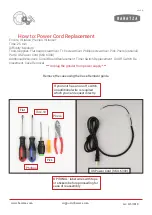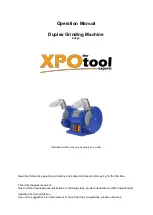
12
www.raider.bg
e) Do not overreach. Keep proper footing and balance at all times. This enables better control of the power tool in
unexpected situations.
f) Dress properly. Do not wear loose clothing or jewelry. Keep your hair, clothing and gloves away from moving parts.
Loose clothes, jewelry or long hair can be caught in moving parts.
g) If devices are provided for the connection of dust extraction and collection facilities, ensure these are connected
and properly used. Use of dust collection can reduce dust-related hazards.
4) POWER TOOL USE AND CARE
a) Do not force the power tool. Use the correct power tool for your application. The correct power tool will do the job
better and safer at the rate for which it was designed.
b) Do not use the power tool if the switch does not turn it on and off. Any power tool that cannot be controlled with the
switch is dangerous and must be repaired.
c) Disconnect the plug from the power source and/or the battery pack from the power tool before making any
adjustments, changing accessories, or storing power tools. Such preventive safety measures reduce the risk of starting
the power tool accidentally.
d) Store idle power tools out of the reach of children and do not allow persons unfamiliar with the power tool or these
instructions to operate the power tool. Power tools are dangerous in the hands of untrained users.
e) Maintain power tools. Check for misalignment or binding of moving parts, breakage of parts and any other condition
that may affect the power tool’s operation. If damaged, have the power tool repaired before use. Many accidents are
caused by poorly maintained power tools.
f) Keep cutting tools sharp and clean. Properly maintained cutting tools with sharp cutting edges are less likely to bind
and are easier to control.
g) Use the power tool, accessories and tool bits etc., in accordance with these instructions, taking into account the
working conditions and the work to be performed. Use of the power tool for operations different from those intended could
result in a hazardous situation.
5) SERVICE
a) Have your power tool serviced by a qualified repair person using only identical replacement parts. This will ensure
that the safety of the power tool is maintained.
SAFETY INSTRUCTIONS FOR HIGH-SPEED ROTATION TOOLS
1) SAFETY INSTRUCTIONS FOR ALL OPERATIONS
a) This power tool is intended to function as a grinder, sander, wire brush, polisher, carving or cut-off tool. Read all
safety warnings, instructions, illustrations and specifications provided with this power tool. Failure to follow all instructions
listed below may result in electric shock, fire and/or serious injury.
b) Do not use accessories which are not specifically designed and recommended by the tool manufacturer. Just
because the accessory can be attached to your power tool, it does not assure safe operation.
c) The rated speed of the accessory must be at least equal to the maximum speed marked on the power tool.
Accessories running faster than their rated speed can fly apart.
d) The outside diameter and the thickness of your accessory must be within the capacity rating of your power tool.
Incorrectly sized accessories cannot be adequately controlled.
e) The arbour size of wheels, sanding drum or any other accessory must properly fit the spindle or collet of the power
tool. Accessories that do not match the mounting hardware of the power tool will run out of balance, vibrate excessively
and may cause loss of control.
f) Mandrel mounted wheels, sanding drums, cutters or other accessories must be fully inserted into the collet or chuck.
The “overhang” or the length of the mandrel from the wheel to the collet must be minimal. If the mandrel is insufficiently
held and/or the overhang of the wheel is too long, the mounted wheel may become loose and ejected at high velocity.
g) Do not use a damaged accessory. Before each use inspect the accessory such as abrasive wheels for chips
and cracks, sanding drum for cracks, tear or excess wear, wire brushes for loose or cracked wires. If the power tool
or accessory is dropped, inspect for damage or install an undamaged accessory. After inspecting and installing an
accessory, position yourself and bystanders away from the plane of the rotating accessory and run the power tool at
maximum no load speed for one minute. Damaged accessories will normally break apart during this test time.
h) Wear personal protective equipment . Depending on application, use face shield, safety goggles or safety glasses.
As appropriate, wear dust mask, hearing protectors, gloves and shop apron capable of stopping small abrasive or
workpiece fragments. The eye protection must be capable of stopping flying debris generated by various operations. The
dust mask or respirator must be capable of filtrating particles generated by your operation. Prolonged exposure to high
intensity noise may cause hearing loss.
i) Keep bystanders a safe distance away from work area. Anyone entering the work area must wear personal
protective equipment. Fragments of the workpiece or of a broken accessory may fly away and cause injury beyond the
immediate area of operation.
j) Hold power tool by insulated gripping surfaces only, when performing an operation where the cutting accessory may
contact hidden wiring or its own cord. A cutting accessory contacting a “live” wire may make exposed metal parts of the
power tool “live” and could give the operator an electric shock.
k) Always hold the tool firmly in your hands during the start-up. The reaction torque of the motor, as it accelerates to
full speed, can cause the tool to twist.
l) Use clamps to support workpiece whenever practical. Never hold a small workpiece in one hand and the tool in
the other hand while in use. Clamping a small workpiece allows you to use both hands to control the tool. Round material
such as dowel rods, pipes or tubing have a tendency to roll while being cut, and may cause the bit to bind or jump toward
you.
m)Position the cord clear of the spinning accessory. If you lose control, the cord may be cut or snagged and your hand
or arm may be pulled into the spinning accessory.
n) Never lay the power tool down until the accessory has come to a complete stop. The spinning accessory may grab
the surface and pull the power tool out of your control.
o) After changing the bits or making any adjustments, make sure the collet nut, chuck or any other adjustment
devices are securely tightened. Loose adjustment devices can unexpectedly shift, causing loss of control, loose rotating
components will be violently thrown.
p) Do not run the power tool while carrying it at your side. Accidental contact with the spinning accessory could snag
your clothing, pulling the accessory into your body.
Содержание RD-MG09
Страница 50: ...50 www raider bg ...
Страница 52: ...52 www raider bg ...
Страница 54: ...54 www raider bg ...
Страница 61: ...61 ...













































